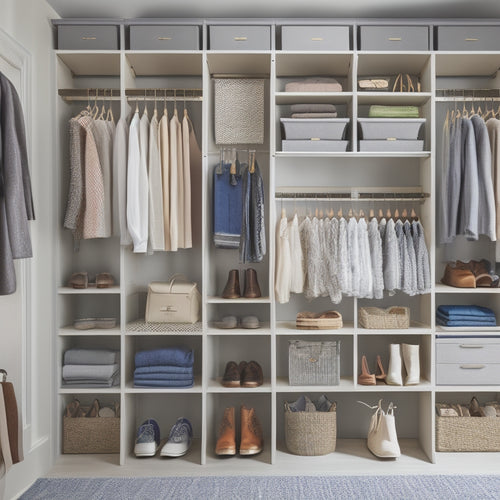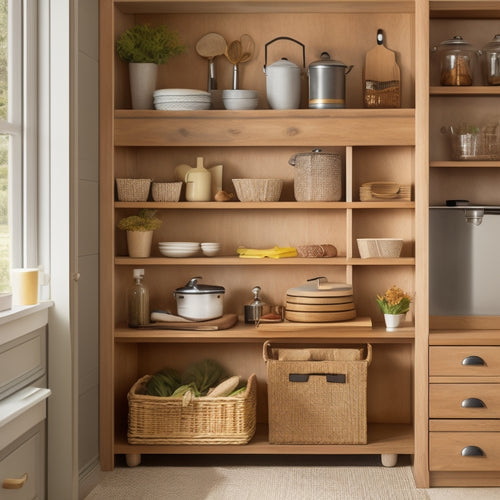
Efficient Kids Closet Organization: Decluttering Tips
Share
I've developed a system to organize my kid's closet that not only teaches them essential skills like decluttering and decision-making, but also creates a peaceful and functional space that makes mornings a whole lot easier. I start by involving my kid in donation drives and decluttering games to remove unnecessary items and teach the value of giving back. Then, I utilize space-saving hacks like categorizing clothing items and bins for storage. Finally, I maximize storage space by using vertical shelves and labeling bins, making it easy for my kid to find what they need. Now, I'm ready to share more strategies to get their closet running smoothly.
Key Takeaways
• Involve kids in decluttering and donation drives to instill responsibility and gratitude while streamlining closet essentials.
• Utilize space-saving hacks like categorizing clothing items, using bins, and maximizing vertical space to increase storage capacity.
• Simplify clothing choices by involving kids in decision-making and prioritizing essential items, letting go of unwanted ones.
• Teach kids essential skills like decision-making, critical thinking, and giving back through donation drives and decluttering activities.
• Create a functional space by labeling bins, implementing underbed storage, and prioritizing a clutter-free closet for easy access.
Streamlining Closet Essentials
My kid's closet is most efficient when it's stocked with only what they truly need, so I prioritize streamlining their closet essentials to guarantee easy access and a clutter-free space.
To achieve this, I involve my kid in donation drives and decluttering games, teaching them the value of giving back while having fun. By removing unnecessary items, we create space for what's truly important.
I also implement space-saving hacks like categorizing clothing items and utilizing bins for storage. This approach not only keeps their closet organized but also instills a sense of responsibility and gratitude in my child.
Maximizing Storage Space
By strategically utilizing closet shelves and bins, I'm able to maximize storage space and keep my kid's closet organized, making it easy to find what they need when they need it. Here's how I optimize storage:
| Strategy | Benefits | Tips |
|---|---|---|
| Using vertical space | Increases storage capacity | Install shelves or storage units that go up to the ceiling |
| Utilizing underbed storage | Stores out-of-season or bulky items | Choose bins with wheels for easy access |
| Labeling bins and shelves | Easy identification of contents | Use a label maker to create clear labels |
Simplifying Clothing Choices
Involving kids in the decision-making process helps them develop essential skills in simplifying their clothing choices, making it easier for them to pick out outfits and maintain a clutter-free closet. By doing so, I'm teaching them to make decisions and prioritize what they really need.
This process of elimination helps minimize clutter and keeps their closet organized. I encourage them to ask themselves questions like 'Do I love this item?' or 'Have I worn it in the past year?' This helps them develop a critical thinking approach to making decisions about their clothing.
As a result, they learn to let go of unwanted items, making space for new ones and keeping their closet clutter-free.
Frequently Asked Questions
How Often Should I Involve My Kids in the Donation Process?
I involve my kids in the donation process regularly, teaching empathy and building confidence as they learn to let go of unwanted items, making a positive impact on others, and developing a sense of responsibility.
What's the Best Way to Store Out-Of-Season Clothing Items?
I store out-of-season clothing items using vacuum storage bags and closet dividers, keeping them organized, easily accessible, and protected from dust, while maximizing my closet space and ensuring a clutter-free environment.
Can I Donate Clothes That Are Slightly Worn or Damaged?
I check donation standards and charity guidelines before giving away slightly worn or damaged clothes, ensuring they're acceptable and will truly benefit those in need, rather than adding to landfill waste.
How Do I Keep My Child From Getting Too Attached to Certain Clothes?
As I help my child declutter, I acknowledge their emotional connection to certain clothes, identifying memory triggers that make them hard to part with, and gently encourage them to let go, creating space for new memories.
What's the Ideal Age to Start Teaching Kids About Donating Clothes?
"I'm throwing a gazillion clothes on the floor, and I'm still holding on! But seriously, I think the ideal age to teach kids about donating clothes is around 4-5, when they start developing empathy and building responsibility, making them more receptive to the concept."
Conclusion
By implementing these simple yet effective decluttering tips, my kids' closets have transformed from chaotic messes to havens of calm and efficiency.
And it's not just about aesthetics - did you know that the average American throws away 82 pounds of textile waste per year?
By teaching our kids the importance of closet organization, we're not only reducing stress and increasing productivity, but also instilling valuable lessons about sustainability and responsible consumption.
Related Posts
-

Maximize Your Space: 10 DIY Closet Hacks
You can open up to 30% more storage space in your closet by implementing a few simple DIY hacks. Start by maximizing ...
-

Space-Saving Essentials for the Modern Home Cook
As you optimize your kitchen, you'll find that space-saving essentials can make all the difference. You'll appreciate...
-

7 Creative Corner Cabinet Storage Solutions
You're looking to reveal the full potential of your corner cabinets, and you're not alone - maximizing storage in the...


